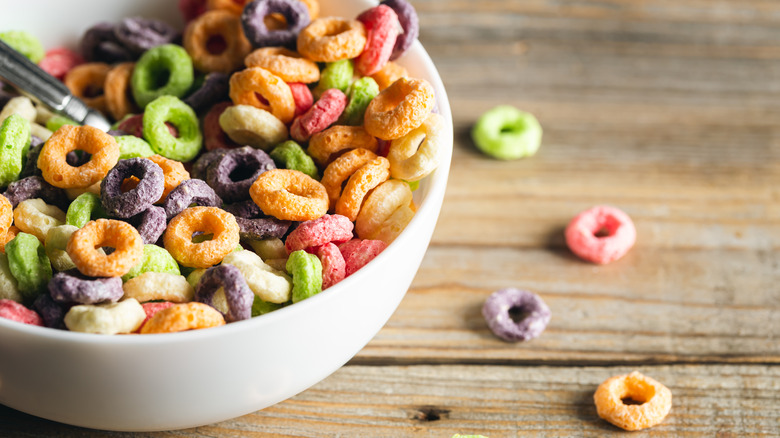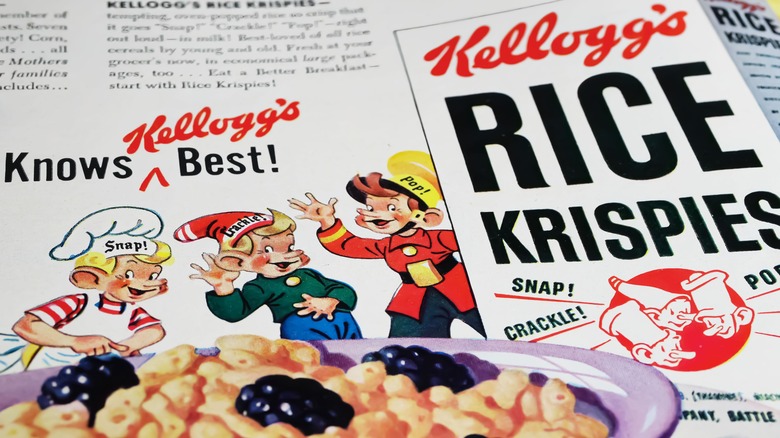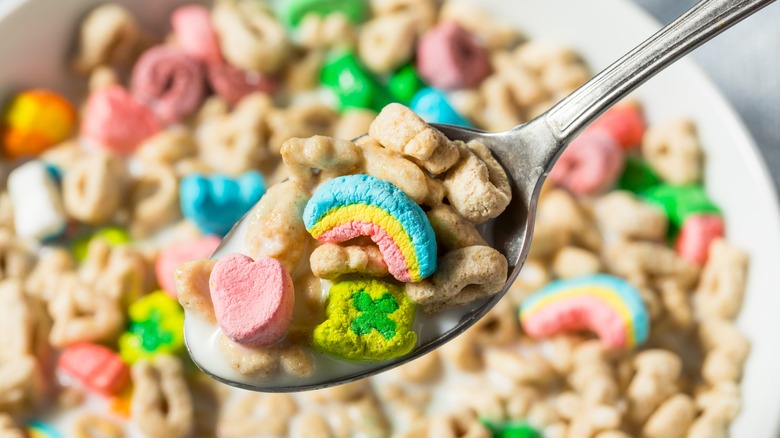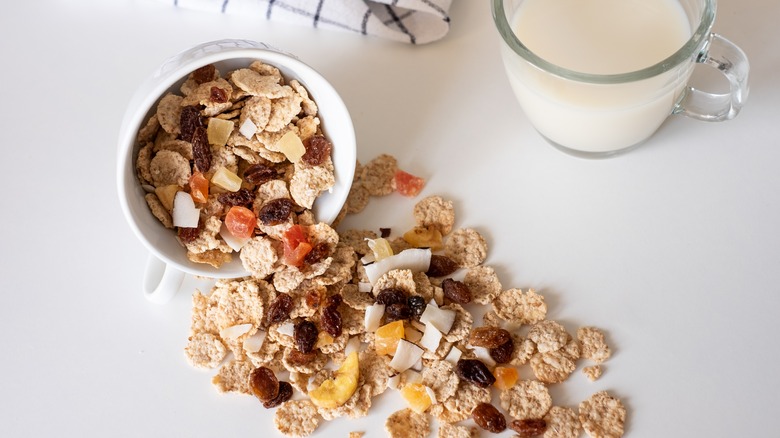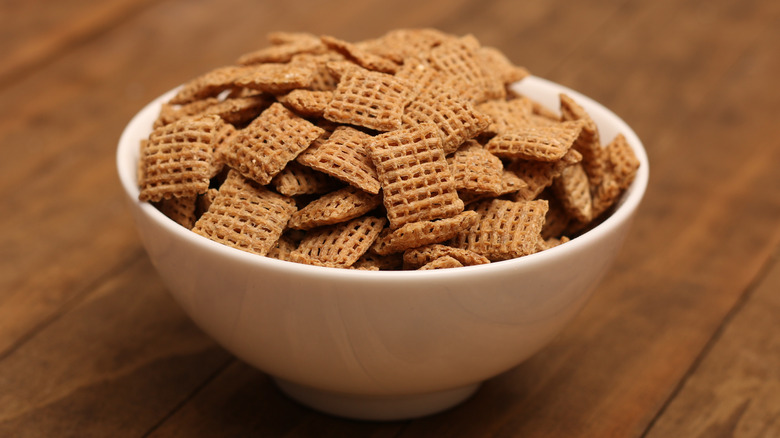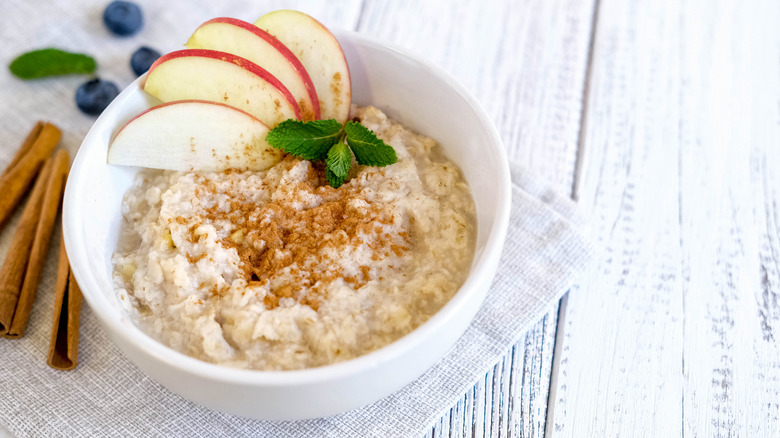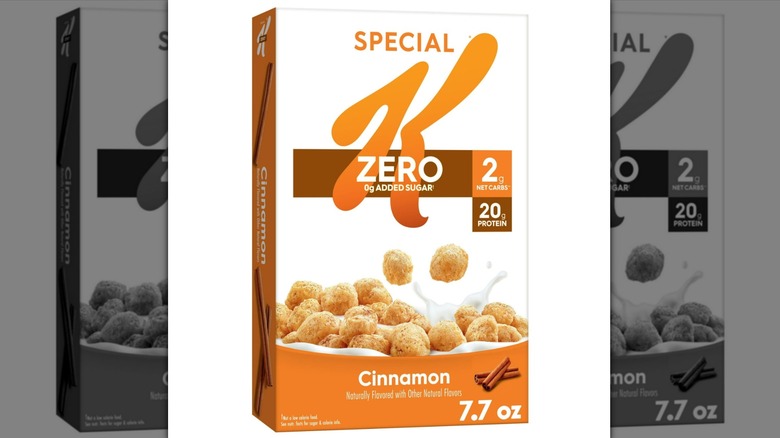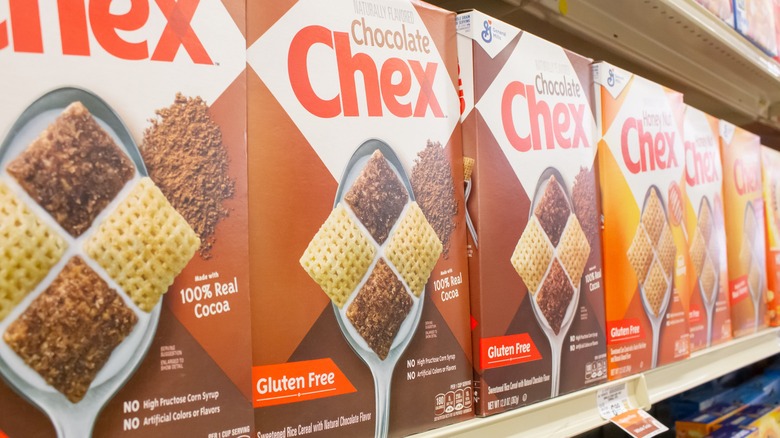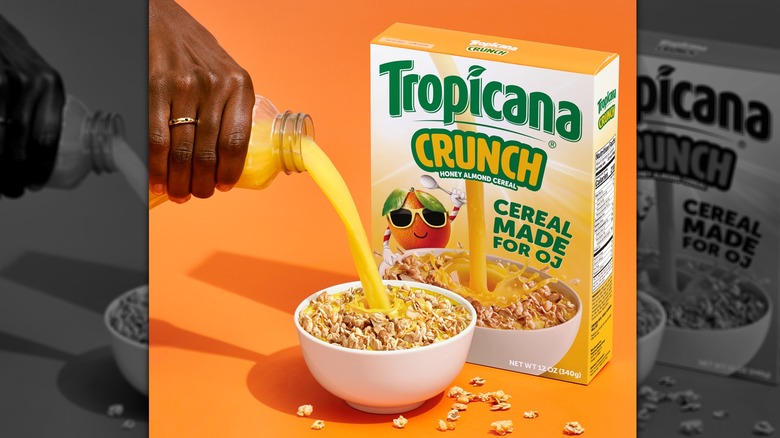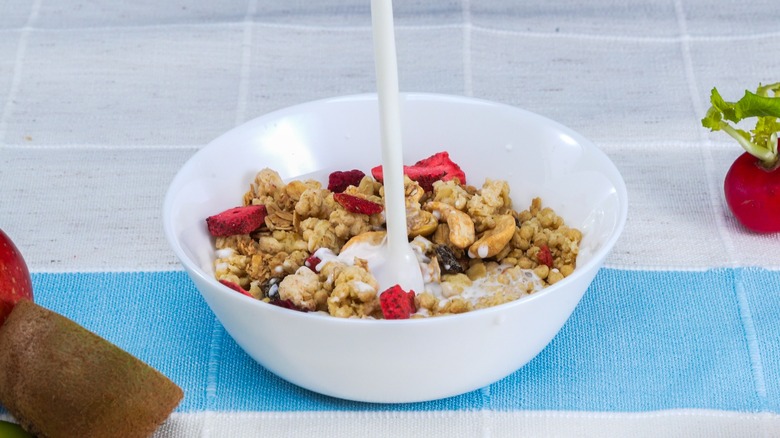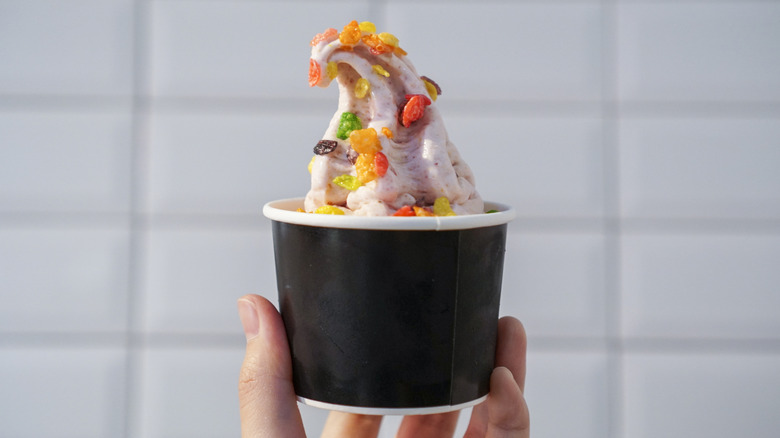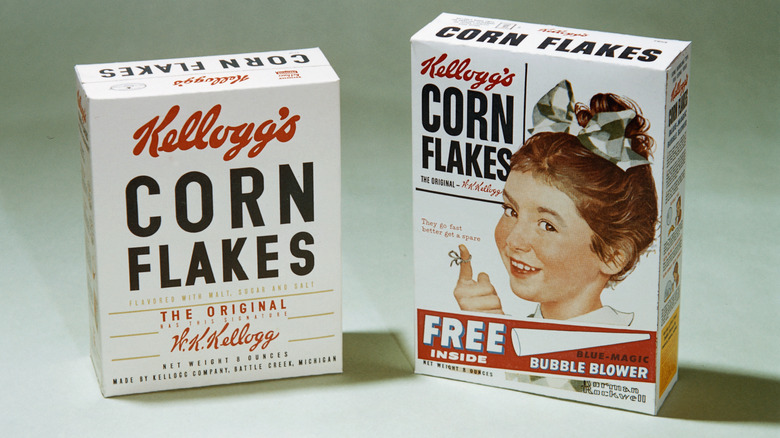False Facts About Cereal You Thought Were True
We may receive a commission on purchases made from links.
Whether you prefer pancakes and maple syrup, an omelet, or a plate full of bacon, breakfast food is undeniably one of the tastiest meals of the day. But in the hustle and bustle of getting ready for school or work, there's not always time to make an elaborate meal first thing in the morning. Luckily, a bowl of cereal with milk takes only seconds to prepare.
While cereal is increasingly popular in other countries, the U.S. leads the way as the largest market for cereal sales, according to data this year from Innova Market Insights. In a 2023 poll conducted by CivicScience, 70% of U.S. households reported enjoying the convenient breakfast food. More than half of households eat cereal at least once a week, the poll found. Love it or hate it, cereal is one of those foods that most people have likely tried at some point in time. However, there are many false facts and myths floating around concerning cereal. To help set things straight, we gathered some of the most common misconceptions and debunked each and every one. We hope this helps you make more informed decisions while shopping. And who knows? Maybe this will help resolve some long-unanswered questions about your favorite breakfast food.
False: Cereal was invented by Kellogg's
Cereal is a rather recent phenomenon. One of the largest brands on store shelves today, Kellogg's was an early promoter of the breakfast food. But it's a common misconception that the Kellogg's company invented cereal. The true story goes back to 1863, when James Caleb Jackson, the manager of a health sanitorium, created a dough using graham flour that he then dried and separated into pieces. These pieces, which he called granula, needed to sit in milk overnight before they were soft enough to eat.
Another sanitarium operator, John Harvey Kellogg, was inspired by Jackson's creation and launched his own take, calling it granola. One of Kellogg's patients, C.W. Post, would go on to invent Grape-Nuts, a cereal brand that remains popular to this day. Kellogg and his younger brother, Will Keith Kellogg, kept at it and soon turned their focus to ready-to-eat cereals. They introduced the world to Corn Flakes and, shortly after that, Rice Krispies. Other brands followed suit, giving rise to the breakfast cereal industry as we know it.
False: Cereal is always full of sugar
Over the years, cereal has earned a reputation for being packed full of sugar. Bright color schemes, cartoon mascots, and fun flavors that are typically geared toward kids 一 all of these signify you're buying a sweet breakfast cereal. Cereal-makers pushed the boundaries further, offering mini chocolate chip cookies or flakes frosted with sugar. Some of the stranger cereals ever sold included tiny Pop Tarts and colorful Sour Patch Kids pieces touting a sour-then-sweet flavor.
There's no doubt that sugary cereals are a problem. After all, ready-to-eat cereal is among the top sources of added sugar in Americans' diets, right there alongside candy, soft drinks, and ice cream, according to Harvard Health. But before you write off all cereal completely, know that there's a whole variety of options with minimal added sugar. Cleveland Clinic recommends choosing a cereal with no more than 9 grams of added sugar per serving.
Luckily, there are many cereals that fit this bill. For example, Kashi GO Original Cereal contains 7 grams of added sugar. Corn Flakes have 4 grams of added sugar. Cheerios have only 1 gram of added sugar. For a zero-sugar cereal option, the brand Magic Spoon uses monk fruit, a natural sweetener, instead of sugar. The important takeaway here is to read the label carefully. Many cereals go heavy on the sugar, but there are definitely healthier options out there.
False: All cereal is heavily processed
Another common myth is that all breakfast cereal is highly processed. While this is true for many cereals, there's been a huge call for whole-grain options in recent years. Compared to their refined counterparts, whole grains have more nutritional value. To break it down, a whole grain consists of an outer layer called the bran, a central layer called the endosperm, and the germ, the innermost part. The bran is high in fiber and nutrients such as iron, B vitamins, magnesium, and zinc. The germ, another good source of B vitamins, also contains vitamin E, antioxidants, and healthy fats. During processing, the bran and germ are removed, leaving only the endosperm, which is less rich in nutrients.
Luckily, whole-grain cereals are available at most stores. Oats, whole wheat, brown rice puffs, and barley are common whole-grain ingredients. When it comes to brands that primarily use whole grains, Kashi, Cascadian Farm, and Food for Life (known for its Ezekiel 4:9 cereals) are a few widely available options. Featuring whole grains in cereals is nothing new, however. Grape-Nuts, a whole-grain cereal that has been around since 1897, remains a simple, healthy choice today.
False: Cereal is always a good source of fiber
Based on the various health claims that many brands make, you might think that all cereal is a good source of fiber. Unfortunately, this isn't always the case. While some cereals are high in fiber, many others contain abysmal amounts. According to the U.S. Food and Drug Administration, most Americans don't get enough fiber in their diets. A diet rich in fiber can decrease your chances of developing heart disease, obesity, diabetes, and several types of cancer. The average person needs to consume at least 28 grams of dietary fiber per day, per the FDA's guidelines.
Many popular cereals, however, are low in fiber. For example, Lucky Charms offer 2 grams of dietary fiber per 1-cup serving, and Fruity Pebbles have 0 grams in the same size serving. For reference, Cleveland Clinic recommends choosing a cereal with at least 3 grams of fiber per serving. To count as a high-fiber food, however, a serving of cereal needs to provide at least 20% of the daily value for dietary fiber. One high-fiber option is Cascadian Farm Organic Hearty Morning Fiber Cereal, with 10 grams of fiber per 1-cup serving. An even more widely available choice is General Mills Wheat Chex, with 8 grams of fiber per 1-cup serving.
False: Hot cereal is healthier
Even with rows and rows of options at some stores, it can be difficult to find a cereal that's high in fiber, low in added sugar, and still tasty. You may write off cold cereal altogether and stick with oatmeal or porridge. Hot cereals have a reputation for being healthy, and there is some truth behind this. Oatmeal, for example, is a good source of fiber, protein, vitamins, and minerals. However, hot cereal is not always necessarily healthier than cold cereal. Adding toppings such as brown sugar, maple syrup, or honey in excess can turn your bowl of hot cereal from a balanced breakfast into a sugar frenzy.
Another thing to watch out for is instant hot cereal. While convenient to prepare, some options contain artificial flavors, sweeteners, preservatives, and additives. Others have as much (or more) added sugar as some cold cereals. For example, Kodiak's Maple & Brown Sugar Oatmeal has 10 grams of added sugar per serving (one packet's worth). According to the FDA's recommendations, that's 20% of your added sugar allotted for the day, gone in one small bowl. With any breakfast cereal, always make sure to read the nutrition label closely.
False: Cereal is only for kids
Many people believe that cereal is only for children. It's easy to see why anyone would think this way 一 after all, many cereal boxes are decorated with colorful, cutesy cartoons and often feature collaborations with popular kids' shows, movies, and video games. It all began in the '50s, when sugar rose to popularity as a major ingredient in breakfast cereals. To advertise its new Frosted Flakes, for example, Kellogg's launched the mascot Tony the Tiger, who won over the hearts of children everywhere. Now, it seems like almost every big-brand cereal has had a mascot or two, eager to entice children with their sugary offerings.
While many cereals market themselves toward children, anyone can buy them. Feel free to enjoy a bowl of Cap'n Crunch or Fruit Loops on occasion. Or, consider one of the many cereals that cater more to adults. They tend to have less sugar and more fiber, though every brand is different. If you have special dietary requirements due to a health condition, there's likely a cereal out there for you, too. For instance, sugar-free muesli and wheat bran cereals are good options for people with diabetes. Adding real fruit, yogurt, and nuts to a bowl of unsweetened whole-grain cereal is a healthy alternative to the sugary, artificially flavored breakfasts of our childhoods.
False: Sugar-free cereals are healthier
We know that many breakfast cereals have too much added sugar. Excessive sugar can lead to weight gain, diabetes, increased blood pressure, and other health problems. Following this logic, you may conclude that sugar-free cereals are always healthier. However, some cereals that market themselves this way use artificial sweeteners and substitutes instead.
Take Kellogg's Special K Zero Cinnamon Cereal. Looking at the nutrition information, the box's claim of zero added sugar is correct 一 instead, the cereal uses sugar substitutes, including the artificial sweetener sucralose. Sucralose tastes much sweeter than regular sugar and contains no calories. While the FDA considers the sweetener safe, some studies have found that consistent consumption of sucralose can lead to elevated insulin and blood sugar levels. Artificial sweeteners can also negatively affect gut health for some people. If you want to avoid artificial sweeteners, cut down on sugar, and still satisfy your sweet tooth, look for naturally sweetened options. Magic Spoon, Nature's Path, and Catalina Crunch all make sugar-free cereals that meet this criteria.
Gluten-free cereals are always better for you
These days, it seems that brands are advertising gluten-free products left and right. Whether due to allergies, sensitivities, or other health reasons, many people are cutting out gluten from their diets. However, just because a cereal labels itself as gluten-free doesn't necessarily mean it's a healthier choice. Gluten-free cereals can still be loaded with sugar and other additives. For example, Cocoa Pebbles and Lucky Charms are gluten-free cereals 一 but by no one's standards can they be considered healthy. Both cereals are high in added sugar and low in fiber and protein.
A less obvious example is Corn Chex, which is free of artificial ingredients, high fructose corn syrup, and gluten. Though not unhealthy, the cereal isn't a great source of fiber or protein. One serving (1 ¼ cup) of Corn Chex contains only 2 grams of dietary fiber and 3 grams of protein. In comparison, a 1-cup serving of Wheat Chex has 8 grams of dietary fiber and 6 grams of protein. Gluten-free cereals are often lower in protein and fiber, which is something to keep in mind when making shopping decisions. Oat-based cereals such as Cheerios typically offer more fiber and protein while still appealing to gluten-free diets.
False: You can only add milk to cereal
Ask anyone: Cereal and milk are a winning combination. Not only does it taste good, but it's also a more filling meal than either one on its own. We're not just talking about cow's milk 一 plant-based milk is a great alternative that works just as well with any type of cereal. But what you may not know is that milk isn't the only liquid you can add to your breakfast bowl.
To the curiosity of some and horror of many, Tropicana launched a limited-release cereal made specifically for orange juice in 2022. Tropicana Crunch consists of honey almond granola clusters, which can supposedly hold up under the acidity of orange juice. While Tropicana Crunch received not-so-favorable reviews from many of those who tried it, in theory you could add orange juice to any cereal. But should you? According to promotional materials from Tropicana, about 15 million Americans have tried orange juice in their cereal.
Perhaps less controversially, other cereals are made with water in mind. Kellogg's Insta-Bowls are one such creation. The conveniently packaged bowls already contain powdered milk, so you only need to add cold water and mix it all together. This way, even if you're out of fresh milk, you can still enjoy your Fruit Loops or Raisin Bran without making any sacrifices.
False: Most Americans now prefer plant-based milk in their cereal
Like with anything, cereal trends come and go, reflecting the values and mindsets of the times. In recent years, it's become increasingly popular to enjoy cereal with plant-based milk. Oat, almond, coconut, soy, or any other alternative milk is suitable for vegans and anyone sensitive or allergic to dairy. Others simply prefer the taste of these milks to the animal-derived kind.
Given the popularity of these alternatives (and the dislike some now have for drinking dairy), you might think that more Americans use plant-based options in their cereals than real milk. However, according to CivicScience polling data, this is far from the truth. As of 2023, 71% of Americans still opt for dairy milk in their cereal bowls. The same data showed only 9% of households preferring to use plant-based milks on their cereal. It remains to be seen whether plant-based milk will one day overtake traditional dairy. For now, though, milk still has a strong hold over our morning routines and the way we enjoy cereal.
False: Cereal is only good for breakfast
A common misconception is that cereal is only for breakfast. It's understandable 一 cereal companies have long marketed their foods this way. Countless commercials have depicted families sitting down to enjoy hearty bowls of cereal at the day's start. But no one is forcing you to limit your cereal eating to the morning. In fact, many types of cereal make for a delicious midday snack. Whether you add milk or enjoy varieties like granola straight out of the bag, cereal can be a satisfying and healthy snack. Of course, consider picking a cereal that's low in added sugar and high in fiber and protein to reap the most benefits for your health.
But that's not all. You can also incorporate some cereal into your lunch or dinner recipes. For instance, plain Corn Flakes can double as a breading for chicken, fish, or tofu, or they can add some crunch to any baked dish. Given the sweetness of many cereals, they also work as a dessert. Other than simply enjoying a bowl of the stuff, you can use your favorite cereal as a topping for your ice cream sundae, or throw some into your cookie or cake batter. You can even make a pie crust using cereal. Try Cheerios, Chex, or even Fruity Pebbles 一 the fun lies in experimenting with different types to achieve varying textures and tastes. Given cereal's versatility and diversity, it may just become your secret ingredient in the kitchen.
False: Cereal boxes no longer come with prizes
You may have fond memories from your childhood of ripping open a new cereal box to find the little plastic figurines or trinkets hiding inside. Sometimes, we even picked out a cereal solely for the prize advertised on the box. Today, however, cereal box prizes seem like a relic of the past. But contrary to popular belief, they still exist. They just might not look like how you remember.
While the era of physical toys in most every cereal box is long gone for the most part, prizes now take another form. Fitting with the interests of young children today, some cereals boast digital prizes, redeemable online. For example, Kellogg's currently makes a Minecraft-inspired cereal called Creeper Crunch that lets fans redeem a special character item in-game with a cereal purchase. Physical prizes also still exist, just not in the box. For instance, as of writing, you can buy Crocs-themed Frosted Flakes that come with marshmallows shaped like Jibbitz shoe charms. You can upload a picture of your receipt online and receive in the mail a real Jibbitz charm, shaped like Tony the Tiger or Toucan Sam, of course. While maybe not as instantly gratifying as finding a toy right inside the box, prizes are still alive and well.
